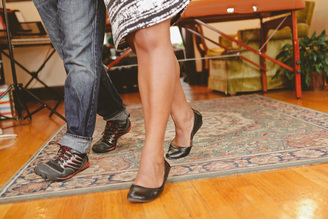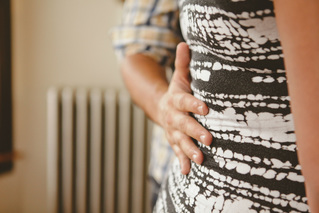 I love my legs. They misbehave. They are often tense. But I love them for it. When I started training as an Alexander Technique teacher, some unrealistic part of me fantasized that by the time I was certified I would have perfect 'use' of my system. My tension would be gone. I would be transformed. Near the beginning of my third year of training, I was beginning to get worried. Early in my first year, we had identified a tough habit of mine--I had a very difficult time directing my legs, particularly my right one. They were often tense beyond my control, I had trouble allowing movement in my hip sockets or giving the weight of the leg over to a teacher when on the table. Two years in, not much had changed day by day. Every once and a while, I would achieve a mysterious freedom in my lower body, but I would never be able to trace the methodology by which I had achieved that ease and within a couple days(if I was lucky) the stiffness was back. I had serious concerns that this problem would be with me forever and would limit my ability to be a good teacher. So I started to focus a ton of work on them. And they got worse. You might identify with this phenomenon. You have a problem clearly identified that you know needs solving. It is urgent in a way that causes you anxiety. And so you tackle it to the best of your ability. And it backfires. Why does this happen? In Alexandrian thought, the above process is an example of the pitfalls of 'endgaining'. Endgaining is simply going after a result with brute force of will rather than a method which addresses the cause of the problem. This is made especially difficult because causation can be very hard to determine. The reason for this is that the problem that needs work is not always the same as the symptoms. An example. People who come to me with back pain often assume its because of something structurally wrong with the alignment of their back. However, I often find that it is the poise of some other part of their body that is causing them trouble--most often habitual tension in the head and the neck, but also habits to do with the person's use of their shoulders, their elbows, their legs; both in general and in specific activities. A pianist I worked with had trouble with pain in her hands; but after working together we discovered the pain in her hands was actually caused not by the way she used them but by inadequate support for her truck caused by the way she used her pelvis and legs while sitting at the piano. With my legs, I have not yet figured out an exact cause. However, my moments of freedom have come when I have given excellent organisation to my own head and neck and allowed that to connect to my pelvis, allowing my legs the ability to function on their own and not have to be tense to make up for poor use in my trunk. Often this is tied to a sense of confidence in myself. I stop worrying about how well I'm using myself when I'm fully connected and good use of my legs comes as a side effect. This is especially interesting as I noticed something in my third year of training. My legs would get more tense whenever I was feeling more nervous and less confident in myself. So when I was trying hard to 'correct' what I saw as a major fault in myself, my nervousness was actually fueling and reinforcing the thing I was trying to change. This was a major breakthrough for me. Since then, every time I notice tension in my legs, I refocus on treating my self as a whole well. My legs have become the canary in the coal mine that tell me when I need to be taking better care with my use and the way I think about myself. If I catch myself over-criticizing them, I just take a breath, say "**** it"(which was some of the best advice my Trainer Daria every gave me), and move on. And as a result, I have transformed a cycle of dislike towards them into gratitude for the gift of information they give me. And as I've worked to transform this cycle of dislike, they've slowly started to change into better organisation. They aren't perfect. They probably won't every be. If I am conscious of them being close to perfect, that will be the moment I lose it. But they have gotten better with time. And mostly, I've learned how to be better towards them.
2 Comments
What's life without a little mystery?
I would be lying to you if I claimed we knew exactly what happens when an Alexander teacher does 'hands on' work with a student. This aspect of teaching is perhaps the most unique facet of Alexander work and the most pleasurable. In my experience, trying to describe, or listening to my students try to describe, what it is like to have hands on work done usually results in a squint from the listener and a response along these lines: 'So its like massage?' or 'So its like Reiki?' It is human nature to try to try to categorize experiences by what we already know--even when the experience is completely foreign. This usually results in simile that prompts a response such as'well, I can't really describe it, you'll just have to try it' from the person trying to communicate their experience. Which sounds snobby. Many teachers will refuse to even attempt to describe the 'hands-on process' to a student under the rationalization that it could lead to misleading ideas about the Technique or out of reverence for the 'mystery' of the process. I, however, think that in order for someone to try something new, they deserve to know a bit about what that new thing is before they do it. Otherwise, why would they? So, here is my stab at explaining how Alexander Hands work, or at least one perspective on it. I believe that Alexander Hands primarily have a relationship to a field of Neuroscience called body mapping. Most of my understanding on this comes from the excellent book 'The Body has a Mind of its Own' by Sandra & Matthew Blakeslee. The basic concept is this: every touch cell in your body has a corresponding cell in your brain, arranged vaguely in a miniature map of your body. When you are touched by something, the corresponding cells light up on the map in your brain.. Not every part of your body has the same number of touch cells--the hands and the mouth, for instance, are loaded with them, while your back and torso is a no mans land with relatively few cells. The body map in your brain reflects this. When an Alexander teacher puts 'hands on', they are lighting up part of the body map in your brain, most often parts that do not often receive much attention. This awareness gives the student a wealth of new information--of the relative position of the part in question, the level of tension in it, and its relationship to the whole body map. So the first thing the hands give a student is self-awareness. The second thing the hand gives is a slight coaxing for the area touched to release--really a pause in the constant stream of tension in the muscles under the skin. This can be compared to the refusal to respond habitually so paramount in the Alexander process known as 'Inhibition'. This is communicated through the openness of the hand and its quality of release, which we are able to sense. The third thing the hand communicates is a sense of what in A.T. is called Direction. For the purposes of this blog, I am going to define Direction as a 'thought nudge' which helps to coax the muscles in question into better, more natural and functional Use. This is maybe the most fascinating aspect of the body mapping connection. Besides mapping our sense of our own body, the brain also extends our sense of touch to map anything we touch. This is why when you ride in a car and go over the bump, you can feel the wheels hit the bump even though all you are touching is your seat or the floor under your feet. Or why when you hit a baseball you feel the ball hit the end of the bat when all you are touching is the handle. So when a teacher touches the student, they are 'sharing' their body map with the student. The student is then able to compare their sense of how the teacher is using their body with their own heightened awareness of part being touched, and can use this information to subtly encourage their own use to mirror their teachers. This is perhaps one of the reasons why a teacher's Use of themself makes a difference in the quality of their teaching The result of this process-- heightened awareness, encouragement to pause ones habitual use of ones muscles, and learning how to Direct from the teacher's Use--is that the student makes subtle decisions about how to employ their muscles and let go of tension(or increase connection--every person is completely unique in what they need and how it connects to their whole system). So rather than the teacher 'doing' something to the student, the teacher facilitates the student to help themself. What it usually feels like is very simply becoming more present--and a sense of shift as your system incorporates the new use of the part into the body as a whole, possibly accompanied by a sense of release. These decisions then become more and more conscious and habitual, allowing you to have a more energized body map and make better decisions about how to use yourself even without your teacher. Okay. Clear as mud? Why don't you give it a try! |
Thoughts on what is going on in the work and the world right now. Many posts to come. Archives
June 2021
Categories |

 RSS Feed
RSS Feed